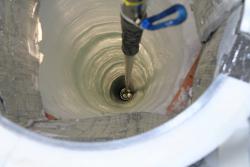Most of us are familiar with Neutrons, the neutral particle that often resides in the nucleus of atoms. Those are the particles that the CosRay neutron detectors are investigating. They are liberated from nuclei during collisions with cosmic rays (see my previous journal for more information). But there is another particle detector in Antarctica, called the IceCube neutrino observatory, that studies a different particle altogether.
 The IceCube building. Photo by Katey Shirey.
The IceCube building. Photo by Katey Shirey.
As the name implies, IceCube neutrino observatory detects neutrinos. Neutrinos are particles that interact with matter only through the nuclear weak force and gravity. And since the mass of the neutrino is much smaller than that of the other known elementary particles, it is very hard to detect. In fact, if you want to have a 50% chance of stopping a neutrino then you would need a piece of lead a light-year long to get those odds! Basically, a neutrino needs to interact directly with the nucleus of an atom to be detected.
Science-y details about the detection:
When a fast moving particle enters a new material it can be going faster than light travels through that material (not faster than light in a vacuum … nothing is faster than that). This can cause the particle to emit light in a phenomena that is kind of like a sonic boom for light called Cherenkov radiation.
So when neutrinos hit the nucleus of an atom this can lead to the creation of light, which is comparatively easy to detect. The only problem is that direct collisions between neutrinos and nuclei are fairly rare. So you need to look at a LOT of nuclei that have a LOT of neutrinos going through them. That is one of the reasons that the IceCube neutrino observatory is so impressive. IceCube gets its name from the fact that is composed of a cubic kilometer of ice … now that is a lot of volume for collisions to happen. And there are no shortage of neutrinos. A quick estimate of the number of neutrinos coming from the sun would give a result of about 65 billion neutrinos, passing through just one square centimeter of area on earth, every second! So if you look hard enough, a few interactions are bound to happen.
 A hole drilled for a string of IceCube light detectors. Photo by Casey O'Hara
A hole drilled for a string of IceCube light detectors. Photo by Casey O'Hara
So why is it in Antarctica? It turns out that since ice is fairly dense, it makes a pretty good detector. And there is a lot of ice in Antarctica. Also the South Pole is so cold that the way the ice freezes makes it very clear, which makes detecting the light (Cherenkov radiation) easier. I probably won’t be making the trip from McMurdo to South Pole Station, but if you want some more information then follow my friend Kate, who will be working with IceCube very soon. It should be very cool because the neutrinos that they are studying can come from some pretty amazing places like black holes, other galaxies, and other high energy astronomical sources!


Comments